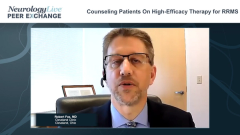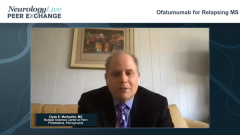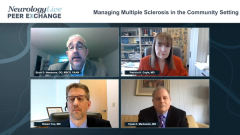
Monitoring Treatment Response in Relapsing-Remitting MS
Recommendations regarding how to monitor patients who receive therapy for relapsing-remitting multiple sclerosis and to conduct repeat imaging assessments appropriately.
Episodes in this series

Scott D. Newsome, DO, MSCS, FAAN: Bob, I am going to ask you a couple more questions. Let’s say you start the therapy, whatever the therapy is. You can choose it. How do you monitor whether a person is having an appropriate response to that therapy, and if it is a clinical marker or an imaging marker combination thereof?
Robert Fox, MD: This is an important question, and it is important that the patient be on the same page with this. We have all had many patients who come back and say, “I do not feel any better on this drug. I do not think it is working.” That is not the goal of the drug. They say, “That has not made my left arm weakness better or my right eye blurriness better.” That is not the goal of the drug.
All of our MS [multiple sclerosis] therapies have 2 goals, and ultimately a third goal as well. The 2 immediate goals are stopping the clinical relapses—the clinical episodes of neurologic dysfunction—and stopping new lesions as measured by the MRI. The third, later goal is preventing the development of disability over time. That is usually a discussion for later, further down the road, but the most immediate goals are stopping clinical relapses and stopping new lesions on the MRI.
When I see the patient, No. 1 is making it clear that this is the goal: “It is not going to make you feel better. It is not going to get rid of some of the residual symptoms from previous relapses that you still have. This is the goal, and you need to understand that.” When the patient comes back in 6 or 12 months, we review whether they have had a relapse, and whether they have had new lesions on the MRI. How much do we tolerate? That is what is a bit unclear. If they have had 2 relapses that have left them with some residual deficits, then of course that drug is not sufficient. If they have 10 new lesions on the MRI, 2 of which are enhancing, then of course that is not sufficient.
What if they have had 1 minor relapse, and we are not even sure if it is a relapse? They did not need steroids, and they have recovered well from it. For that, I may follow along. What happens if they have just 1 new lesion on their MRI at a year? I do not know when that lesion developed. Their index MRI is usually done quite a bit before they get on their MS therapy, so it is a bit of a judgment call, and we do not have clearly defined numbers at this point to say that, if you have this number of new lesions, then you should change vs not changing. As a general rule of thumb, particularly if the index or the reference MRI was a few months after they started whatever therapy they are on, 2 new lesions over a year is usually enough for me to suggest changing to a new therapy. One lesion may not be quite enough, although it depends on how big the lesion is and where it is located.
Scott D. Newsome, DO, MSCS, FAAN: You mentioned picking up 1 new lesion maybe a year after starting a therapy and not knowing when that occurred. It could have occurred 3 months after starting the therapy, or it could have occurred at 8 months.
Robert Fox, MD: Or it could have occurred in the couple of weeks before they started the therapy when the MRI was done earlier.
Scott D. Newsome, DO, MSCS, FAAN: Yes, absolutely. If you have that scenario, my question to you is when would you repeat the MRI at that point?
Robert Fox, MD: After a patient starts an MS therapy, I will try to get them an MRI at about 3 to 6 months, and that is mostly to get a new baseline of, this is our stake in the ground against which we are going to compare going forward. It is also looking at gadolinium-enhancing lesions because if they still have gadolinium-enhancing lesions at 3 to 6 months, that makes me worry that the therapy is not working. I try to get one at 3 to 6 months after starting their MS therapy, and that is mostly as a new baseline, and then looking at a year or 6 months after that MRI as the true measure of how that drug is doing.
Scott D. Newsome, DO, MSCS, FAAN: Thank you for watching this NeurologyLive® Peer Exchange. If you enjoyed the content, which I hope you did, please subscribe to our e-newsletters to receive up-and-coming Peer Exchanges and other great content right in your in-box.
Newsletter
Keep your finger on the pulse of neurology—subscribe to NeurologyLive for expert interviews, new data, and breakthrough treatment updates.


















































